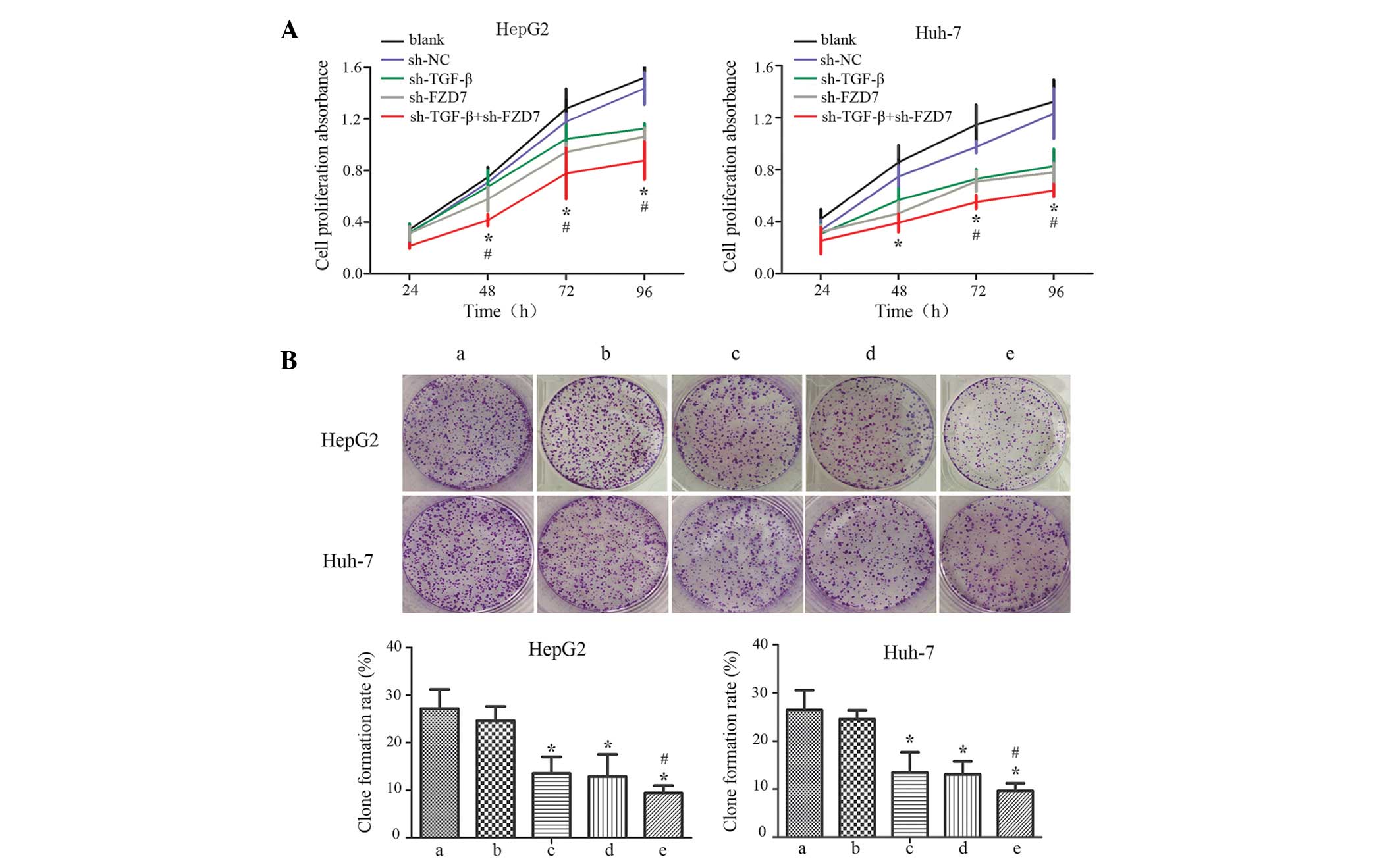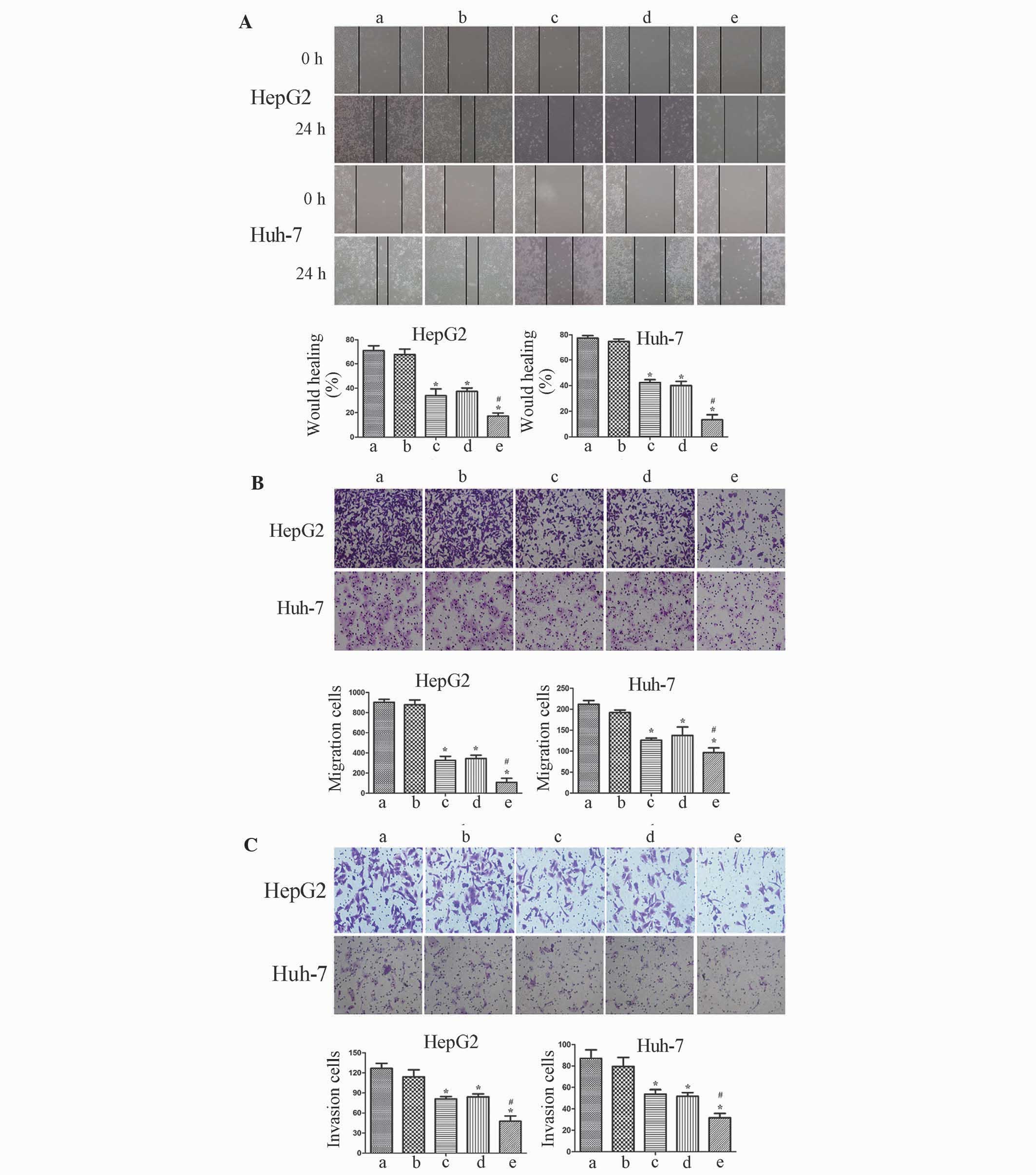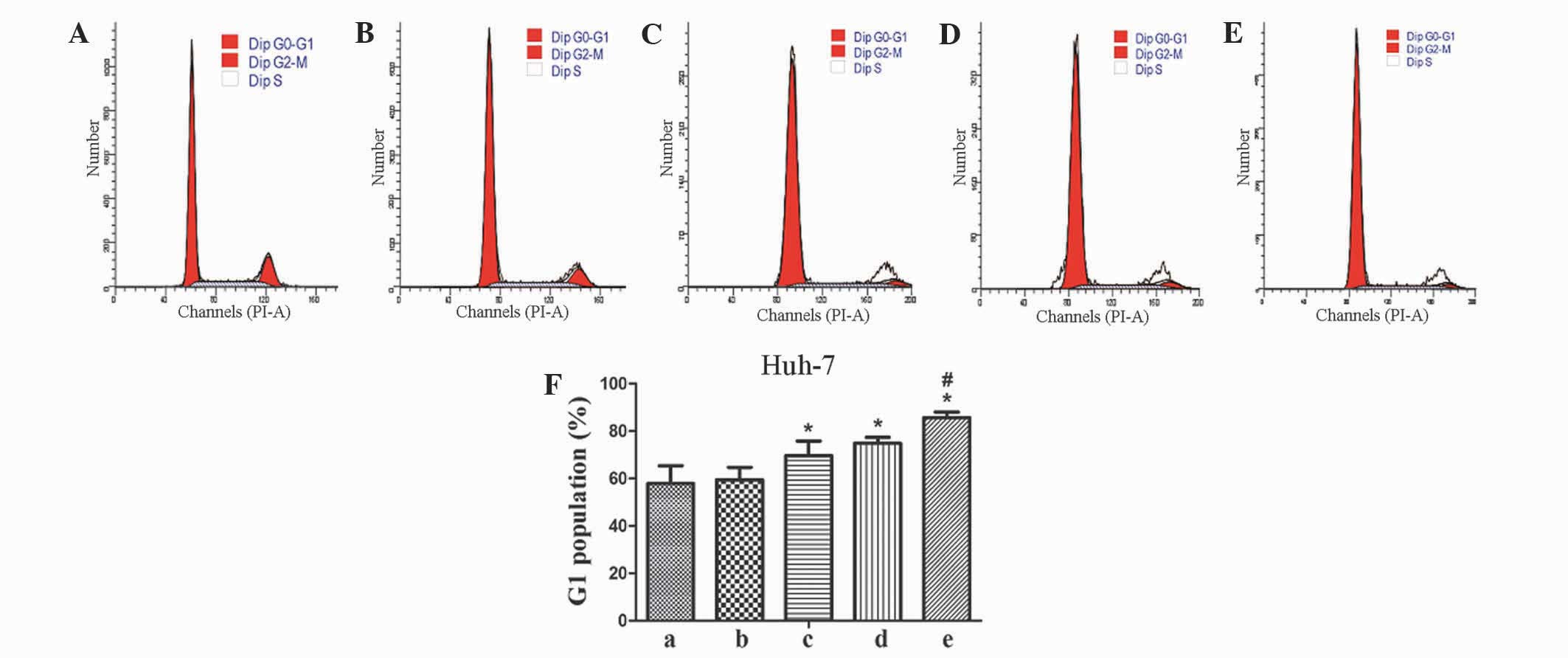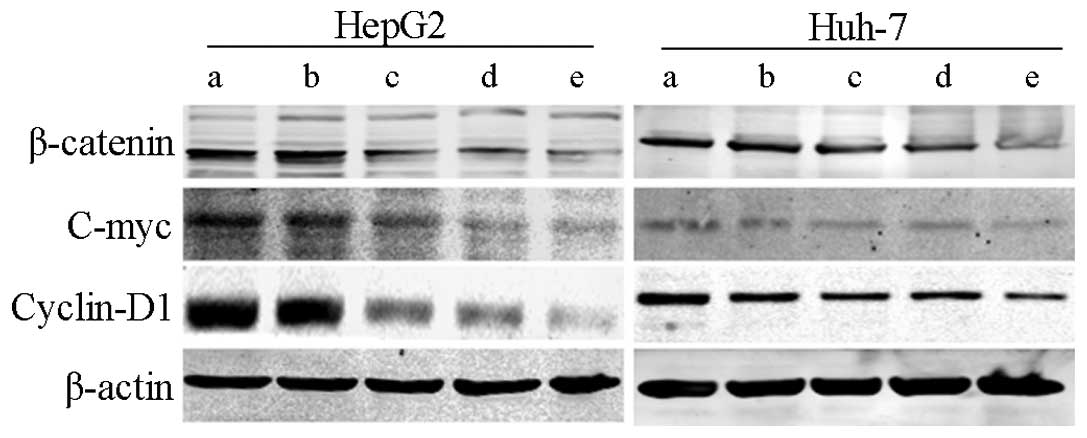|
1
|
Torre LA, Bray F, Siegel RL, Ferlay J,
Lortet-Tieulent J and Jemal A: Global cancer statistics, 2012. CA
Cancer J Clin. 65:87–108. 2015. View Article : Google Scholar : PubMed/NCBI
|
|
2
|
Eskens FA, van Erpecum KJ, de Jong KP, van
Delden OM, Klumpen HJ, Verhoef C, Jansen PL, van den Bosch MA,
Méndez Romero A, Verheij J, et al: Hepatocellular carcinoma: Dutch
guideline for surveillance, diagnosis and therapy. Neth J Med.
72:299–304. 2014.PubMed/NCBI
|
|
3
|
Lee HS, Park MH, Yang SJ, Park KC, Kim NS,
Kim YS, Kim DI, Yoo HS, Choi EJ and Yeom YI: Novel candidate
targets of Wnt/beta-catenin signaling in hepatoma cells. Life Sci.
80:690–698. 2007. View Article : Google Scholar : PubMed/NCBI
|
|
4
|
Ogasawara N, Tsukamoto T, Mizoshita T,
Inada K, Cao X, Takenaka Y, Joh T and Tatematsu M: Mutations and
nuclear accumulation of beta-catenin correlate with intestinal
phenotypic expression in human gastric cancer. Histopathology.
49:612–621. 2006. View Article : Google Scholar : PubMed/NCBI
|
|
5
|
Ozaki S, Ikeda S, Ishizaki Y, Kurihara T,
Tokumoto N, Iseki M, Arihiro K, Kataoka T, Okajima M and Asahara T:
Alterations and correlations of the components in the Wnt signaling
pathway and its target genes in breast cancer. Oncol Rep.
14:1437–1443. 2005.PubMed/NCBI
|
|
6
|
Mårtensson A, Öberg A, Jung A, Cederquist
K, Stenling R and Palmqvist R: Beta-catenin expression in relation
to genetic instability and prognosis in colorectal cancer. Oncol
Rep. 17:447–452. 2007.PubMed/NCBI
|
|
7
|
Fuchs SY, Ougolkov AV, Spiegelman VS and
Minamoto T: Oncogenic beta-catenin signaling networks in colorectal
cancer. Cell Cycle. 4:1522–1539. 2005. View Article : Google Scholar : PubMed/NCBI
|
|
8
|
Willert K and Jones KA: Wnt signaling: Is
the party in the nucleus? Genes Dev. 20:1394–1404. 2006. View Article : Google Scholar : PubMed/NCBI
|
|
9
|
Holland JD, Klaus A, Garratt AN and
Birchmeier W: Wnt signaling in stem and cancer stem cells. Curr
Opin Cell Biol. 25:254–264. 2013. View Article : Google Scholar : PubMed/NCBI
|
|
10
|
Ye N, Wang B, Quan ZF, Pan HB, Zhang ML
and Yan QG: The research progress of the interactions between miRNA
and Wnt/beta-catenin signaling pathway in breast cancer of human
and mice. Asian Pac J Cancer Prev. 15:1075–1079. 2014. View Article : Google Scholar : PubMed/NCBI
|
|
11
|
Roberts AB and Wakefield LM: The two faces
of transforming growth factor beta in carcinogenesis. Proc Natl
Acad Sci USA. 100:8621–8623. 2003. View Article : Google Scholar : PubMed/NCBI
|
|
12
|
Tan Y, Xu Q, Li Y, Mao X and Zhang K:
Crosstalk between the p38 and TGF-β signaling pathways through
TβRI, TβRII and Smad3 expression in plancental choriocarcinoma
JEG-3 cells. Oncol Lett. 8:1307–1311. 2014.PubMed/NCBI
|
|
13
|
Miyazono K, Suzuki H and Imamura T:
Regulation of TGF-beta signaling and its roles in progression of
tumors. Cancer Sci. 94:230–234. 2003. View Article : Google Scholar : PubMed/NCBI
|
|
14
|
Labbé E, Letamendia A and Attisano L:
Association of Smads with lymphoid enhancer binding factor 1/T
cell-specific factor mediates cooperative signaling by the
transforming growth factor-beta and wnt pathways. Proc Natl Acad
Sci USA. 97:8358–8363. 2000. View Article : Google Scholar : PubMed/NCBI
|
|
15
|
Li Z, Zhang LJ, Zhang HR, Tian GF, Tian J,
Mao XL, Jia ZH, Meng ZY, Zhao LQ, Yin ZN and Wu ZZ: Tumor-derived
transforming growth factor-β is critical for tumor progression and
evasion from immune surveillance. Asian Pac J Cancer Prev.
15:5181–5186. 2014. View Article : Google Scholar : PubMed/NCBI
|
|
16
|
Nishita M, Hashimoto MK, Ogata S, Laurent
MN, Ueno N, Shibuya H and Cho KW: Interaction between Wnt and
TGF-beta signalling pathways during formation of Spemann's
organizer. Nature. 403:781–785. 2000. View
Article : Google Scholar : PubMed/NCBI
|
|
17
|
Labbé E, Lock L, Letamendia A, Gorska AE,
Gryfe R, Gallinger S, Moses HL and Attisano L: Transcriptional
cooperation between the transforming growth factor-β and Wnt
pathways in mammary and intestinal tumorigenesis. Cancer Res.
67:75–84. 2007. View Article : Google Scholar : PubMed/NCBI
|
|
18
|
Akhurst RJ and Derynck R: TGF-beta
signaling in cancer - a double-edged sword. Trends Cell Biol.
11:S44–S51. 2001. View Article : Google Scholar : PubMed/NCBI
|
|
19
|
Howard S, Deroo T, Fujita Y and Itasaki N:
A positive role of cadherin in Wnt/β-catenin signalling during
epithelial-mesenchymal transition. PLoS One. 6:e238992011.
View Article : Google Scholar : PubMed/NCBI
|
|
20
|
Merle P, de la Monte S, Kim M, Herrmann M,
Tanaka S, Von Dem Bussche A, Kew MC, Trepo C and Wands JR:
Functional consequences of frizzled-7 receptor overexpression in
human hepatocellular carcinoma. Gastroenterology. 127:1110–1122.
2004. View Article : Google Scholar : PubMed/NCBI
|
|
21
|
Miyazono K, Ehata S and Koinuma D:
Tumor-promoting functions of transforming growth factor-β in
progression of cancer. Ups J Med Sci. 117:143–152. 2012. View Article : Google Scholar : PubMed/NCBI
|
|
22
|
Singh AM and Dalton S: The cell cycle and
Myc intersect with mechanisms that regulate pluripotency and
reprogramming. Cell Stem Cell. 5:141–149. 2009. View Article : Google Scholar : PubMed/NCBI
|
|
23
|
Ferraz C, Lorenz S, Wojtas B, Bornstein
SR, Paschke R and Eszlinger M: Inverse correlation of miRNA and
cell cycle-associated genes suggests influence of miRNA on benign
thyroid nodule tumorigenesis. J Clin Endocrinol Metab. 98:E8–E16.
2013. View Article : Google Scholar : PubMed/NCBI
|
|
24
|
Shi QQ, Zuo GW, Feng ZQ, Zhao LC, Luo L,
You ZM, Li DY, Xia J, Li J and Chen DL: Effect of trichostatin A on
anti HepG2 liver carcinoma cells: Inhibition of HDAC activity and
activation of Wnt/β-Catenin signaling. Asian Pac J Cancer Prev.
15:7849–7855. 2014. View Article : Google Scholar : PubMed/NCBI
|
|
25
|
Lan FF, Wang H, Chen YC, Chan CY, Ng SS,
Li K, Xie D, He ML, Lin MC and Kung HF: Hsa-let-7g inhibits
proliferation of hepatocellular carcinoma cells by downregulation
of c-Myc and upregulation of p16(INK4A). Int J Cancer. 128:319–331.
2011. View Article : Google Scholar : PubMed/NCBI
|
|
26
|
Liao DJ, Thakur A, Wu J, Biliran H and
Sarkar FH: Perspectives on c-Myc, Cyclin D1, and their interaction
in cancer formation, progression, and response to chemotherapy.
Crit Rev Oncog. 13:93–158. 2007. View Article : Google Scholar : PubMed/NCBI
|
|
27
|
Shachaf CM, Kopelman AM, Arvanitis C,
Karlsson A, Beer S, Mandl S, Bachmann MH, Borowsky AD, Ruebner B,
Cardiff RD, et al: MYC inactivation uncovers pluripotent
differentiation and tumour dormancy in hepatocellular cancer.
Nature. 431:1112–1117. 2004. View Article : Google Scholar : PubMed/NCBI
|
|
28
|
Giuriato S, Ryeom S, Fan AC, Bachireddy P,
Lynch RC, Rioth MJ, van Riggelen J, Kopelman AM, Passegué E, Tang
F, et al: Sustained regression of tumors upon MYC inactivation
requires p53 or thrombospondin-1 to reverse the angiogenic switch.
Proc Natl Acad Sci USA. 103:16266–16271. 2006. View Article : Google Scholar : PubMed/NCBI
|
|
29
|
Jemal A, Siegel R, Xu J and Ward E: Cancer
statistics, 2010. CA Cancer J Clin. 60:277–300. 2010. View Article : Google Scholar : PubMed/NCBI
|
|
30
|
Brabletz T, Hlubek F, Spaderna S,
Schmalhofer O, Hiendlmeyer E, Jung A and Kirchner T: Invasion and
metastasis in colorectal cancer: Epithelial-mesenchymal transition,
mesenchymal-epithelial transition, stem cells and β-catenin. Cells
Tissues Organs. 179:56–65. 2005. View Article : Google Scholar : PubMed/NCBI
|
|
31
|
Kim H, Yoo SB, Sun P, Jin Y, Jheon S, Lee
CT and Chung JH: Alteration of the E-Cadherin/β-Catenin complex is
an independent poor prognostic factor in lung adenocarcinoma.
Korean J Pathol. 47:44–51. 2013. View Article : Google Scholar : PubMed/NCBI
|
|
32
|
Nelson WJ and Nusse R: Convergence of Wnt,
beta-catenin, and cadherin pathways. Science. 303:1483–1487. 2004.
View Article : Google Scholar : PubMed/NCBI
|



















